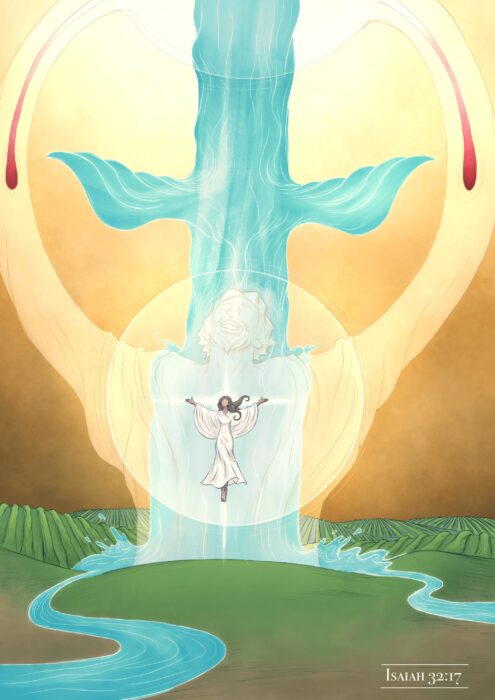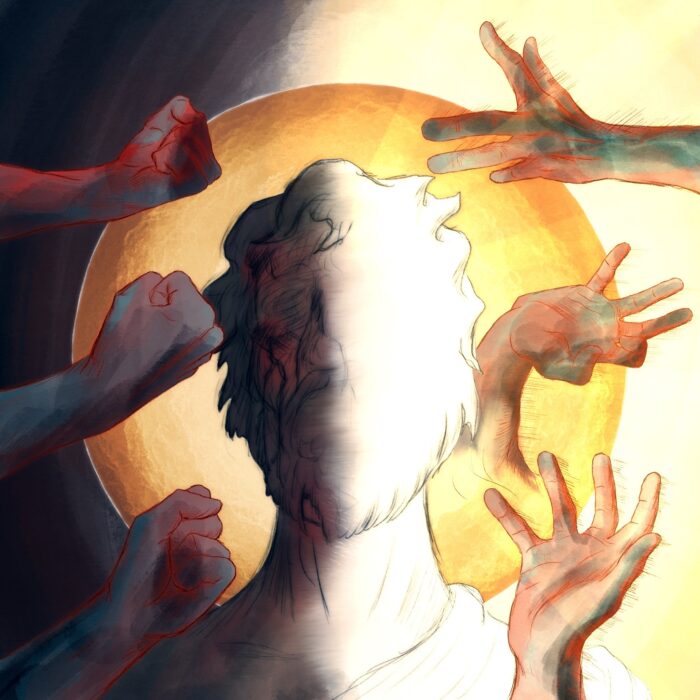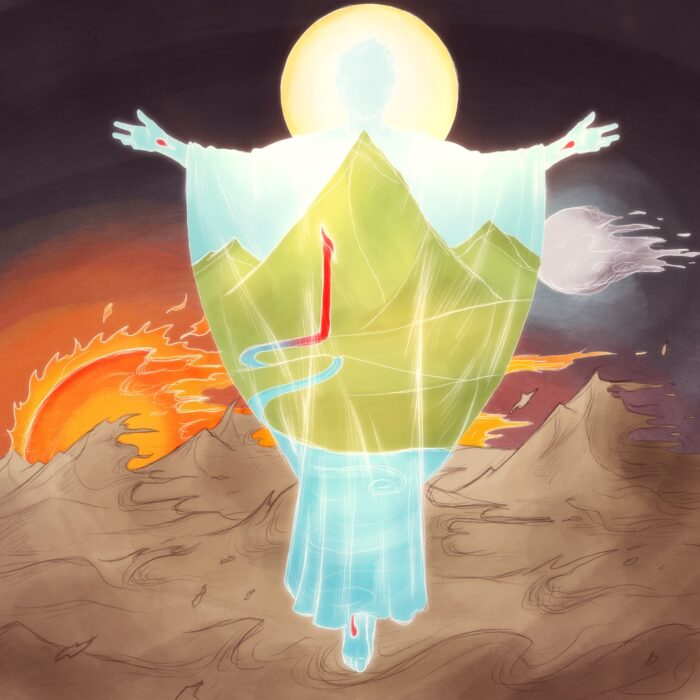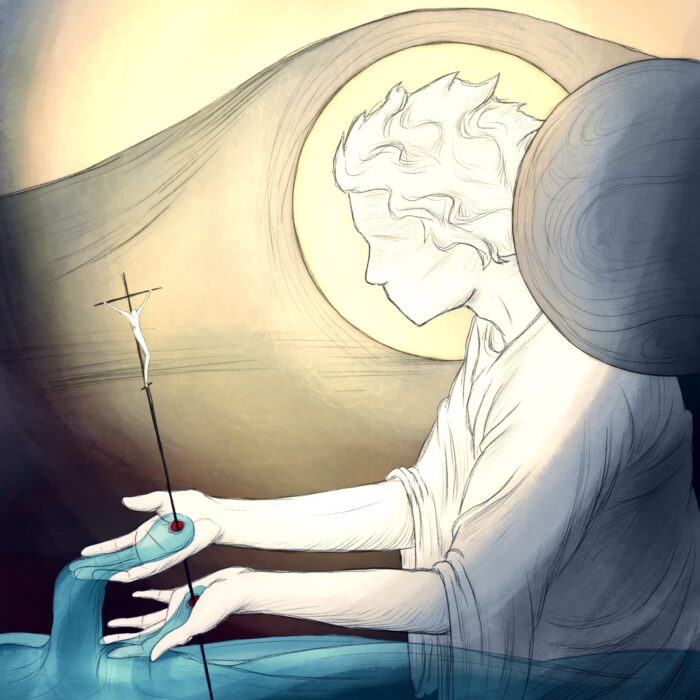
“And the effect of righteousness will be peace, and the result of righteousness, quietness and trust forever.” – Isaiah 32:17
The Passage Explained
Isaiah 32 anticipates the climactic work of redemption that YHWH will achieve for His people—and for all the world. The central agent of this redemption will be the the king who will “reign in righteousness” (32:1). This king is the same figure foreseen in Isaiah 11, the branch who grows from the stump of David’s line (11:1), who is also the “root of Jesse” (11:10), and the signal who is raised in order to assemble the people of God scattered throughout the nations (11:10-12). The New Testament teaches us that this coming king is Jesus Christ, the Son and Lord of David, who is lifted up on the cross as the eschatological act of divine redemption and the signal to whom all the scattered elect are drawn (John 11:51-52, 12:32).
In Isaiah 32, the reign of this king will bring about the righting of wrongs and the alignment of all things to the glory of God (32:3-8). This harmonizing work will be finally achieved through the outpouring of the Spirit of God from on high (32:15). The Spirit, flowing from the ministry of king, will turn the wilderness into a fruitful field, and cause justice and righteousness to “dwell in the wilderness” and “abide in the fruitful field”.
One might wonder how justice and righteousness—terms typically associated with moral agents—can be found in the fields and wilderness. Is Isaiah saying that the grass and dirt will somehow be righteous in the last days? It seems to me that “justice” and “righteousness” here refer to the alignment of all things to God’s character, or again, to the harmonization of all things to His glory. It is not as though the fields and wilderness will make morally righteous decisions, but rather that they—and all creation with them—will be perfectly aligned with the beauty of who God is and so will communicate the Name / Character / Identity / Glory of God to all the rest of creation. Wonderfully, the New Testament teaches us that Christ accomplishes precisely this in His incarnation, life, death, resurrection, and subsequent outpouring of the Spirit. Through the person and work of the slain and risen Jesus, the entire universe is being drawn into harmony with the glory of the triune God (Ephesians 1:9-10; Colossians 1:19-20).
When Isaiah says that righteousness and justice will dwell in the fields and the wilderness, it seems to me that he is saying something very like what he has already anticipated in Isaiah 11:9, “…the earth shall be full of the knowledge of YHWH as the waters cover the sea.” A comparison of chapters 32 and 11 seems to support this conclusion. Isaiah 11 shares much in common with Isaiah 32, most specifically the Spirit-filled reign of the righteous king who aligns all of creation to the glory of God (11:3-9). Chapter 11’s account of creation being made peaceful and righteous is grounded in verse 9 by the assertion that “the earth shall be full of the knowledge of YHWH as the waters cover the sea.” In other words, the bliss of Isaiah 11:3-9 is founded upon the knowledge of the Lord having filled the earth, just as the peace and quietness of Isaiah 32:17 are based upon righteousness.
It would seem, then, that the “righteousness” of 32:17 is synonymous—or nearly so—with the “knowledge of YHWH” in 11:9. For the world to be righteous and full of peace through the ministry of the Spirit-filled king (Isaiah 32) isfor the world to be filled with and conformed to the knowledge of YHWH through the ministry of the Spirit-filled king (Isaiah 11).
If this is all correct, then the peace and quietness and trust that flow from righteousness in 32:11 are the peace and quietness and trust that result from all things being as they ought to be in relation the the Lord. This state of final “Shalom” is still ahead for the created universe, but it is one that can already be experienced—in part—in the lives of the people of God. For those who have been reconciled to God through Christ, Isaiah 32:17 points to the profound rest of soul that flows from a deep and settled knowledge of who YHWH is through the ministry of the Spirit-filled king (11:1-9). Or, said another way, it is the peace, quietness and trust that flow from knowing God in the crucified and risen Son by the illumination of the Spirit. Or, finally, it is is the personal “shalom” that flows from having eternal life (John 17:5).
The death and resurrection of Christ has ensured that one day this peace-producing righteousness—this shalom-creating knowledge of YHWH—will fill the entire universe (Colossians 1:19-20, John 1:5, Revelation 21:23), but until that happens, the individual Christian—and, even more so, the community of Christ’s body here on earth—is an outpost and foretaste of that righteousness. We claim and live in this state of peace-bearing righteousness as we are increasingly conformed to the image of God’s beauty as He has revealed Himself to us in Christ by virtue of our faith in and union to our slain and risen Lord.
The Picture Explained
The central image in this illustration is a representation of the joy filled, crucified-yet-risen Son of God, Jesus Christ. The Son’s face is turned upward toward the unseen Father and the glory of the Father fills the Son with glad laughter. The circular pattern of the Trinity’s eternal fellowship is formed by the hands of the Son, lifted in praise to the Father. On the hands we see the marks of the Son’s crucifixion. This is a reminder that the cross of Christ is grounded in the eternal love of God for God and is the supreme expression of that love (John 14:31). This is significant in light of Isaiah 32:17 because the root of all righteousness is the love of God for God. The righteousness that Isaiah anticipates leading to peace and quiet and trust is a the conformity of all creation to the knowledge of and love for God revealed in Christ. And the cross is not only the ultimate expression of this righteousness, it is also the means by which God achieves the eventual filling of the universe with this righteousness (again, Colossians 1:19-20).
The Spirit is represented as a cascade of water pouring from the Father in love over the Son, and from the Son out into the world. The river of the outpoured Spirit brings life and fruitfulness to the ground as an image of the life that the Spirit gives to God’s people.
Finally, the Bride of Christ is represented in the heart of the Son. The people of God have been united by faith to the Son so that they—as I attempted to picture here—might be drawn up into the Trinitarian joy that the Son has in the Father. To be loved by God as God is loved by God, to know God as God knows God, to love God as God loves God—this is our inheritance in Christ, this is the gift of the gospel, and this is the righteous that yields peace, quietness, and trust in those who receive it.
The Bride mirrors the posture of the Son because—by grace—His acceptance, His joy, His fullness has become hers. However, her posture might also be interpreted as an echo of Christ on the cross—this is highlighted by the radiance of her halo taking the form of a cross. The posture of joy and suffering are the same in this picture because as we follow after the crucified Christ and strive to walk in His own love, we will suffer (whether at the hands of enemies or simply due to the fallen world). However, through His death and resurrection, He has ensured that we will endure these sufferings as beloved ones of the Father—indeed, loved by the Father just as the Son is loved (as I, again, tried to portray in this image).
Until the final harmonization of all things through Christ, hard times will still come, frightening situations will still occur, waves of sorrow will still break into the boat of our hearts…so what’s the difference? What difference does “righteousness” make? The difference is, I believe, that those who have been caught up in the universe-aligning work of Christ, those who have be united to the beloved Son by faith and so are (and are being made) dear children of the Father, beloved by Him with the same love that He loves His son—the difference is that, for these, the hard times and fear and sorrows come from the hand of the one who loves us and are—ultimately—inseparable from His love to us (Romans 8:31-39). All of our “crosses” happen in the context of our communion with the Father, in the Son, under the cascading love of the Holy Spirit. May this assurance lead to peace, quietness, and trust as we await the day when the “earth will be filled with the knowledge of the glory of the LORD…in the face of Jesus Christ” (Habakkuk 2:14 + 2 Corinthians 4:6).




